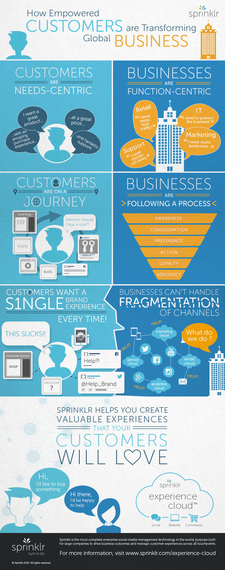I remember the old days when marketers juggled over ten different tools trying to make sense of a flurry of conversations happening online on a variety of channels, across different geographies, about hundreds of different products. We had to piece-mail everything together because none of the products were integrated with each other. It was extremely frustrating.
Then came the marketing cloud with its promise of one view across a variety of marketing activities and consumer conversations. It made a lot of things easier for marketers, and one could argue, for consumers.
But did it really?
I am not so sure.
Marketing cloud... Customer service cloud... Sales cloud... The technologies might have helped with internal efficiencies, but they exasperated the problem of internal silos even more, thus making it harder for companies to provide remarkable customer experiences consistently across a variety of platforms and channels.
Ask yourself: "Does your customer really care what department (s)he is talking to?" Modern customers are informed, have unlimited choices, and expect excellence. If you don't meet - and exceed - their expectations, they will take their business elsewhere. Plain and simple.
When you have the infrastructure that is function-focused vs. need-focused, you run into the problem of presenting your brand in fragmented and inconsistent way. Most of the time that means that your departments don't talk to each other, don't have access to the same data, and don't have one single view of the customer across transactions, channels, and touchpoints.
And that damages your business.
Why? Because if you cannot provide remarkable experiences to your customers consistently, your business will struggle to spark and nurture loyalty. Gartner estimates that, by 2016, 89% of businesses will differentiate primarily on customer experience. Need I say more?
That is why Experience Cloud is the new business imperative. It is a shift away from channel-dependent technologies and into a customer-first, silo-busting world.

Experience Cloud is an infrastructure that allows brands to strive to create valuable, frictionless experiences for their customers. It is the technology that will build bridges between marketing, customer service, sales, PR, etc. in a meaningful way to allow for a single 360-degree view of the customer.
Marketing cloud isn't enough anymore. Sales or customer service cloud isn't enough either.
If brands truly seek to achieve digital transformation and succeed at omni-channel marketing, they need an end-to-end infrastructure that spans across the customer lifecycle. And that is what Experience Cloud does. It enables businesses to create valuable experiences that customers will love across brand websites and 20+ social channels.
Looking to learn more? This Introductory Guide to the Experience Cloud will help.
